#Marchesa Casati Stampa
Photo
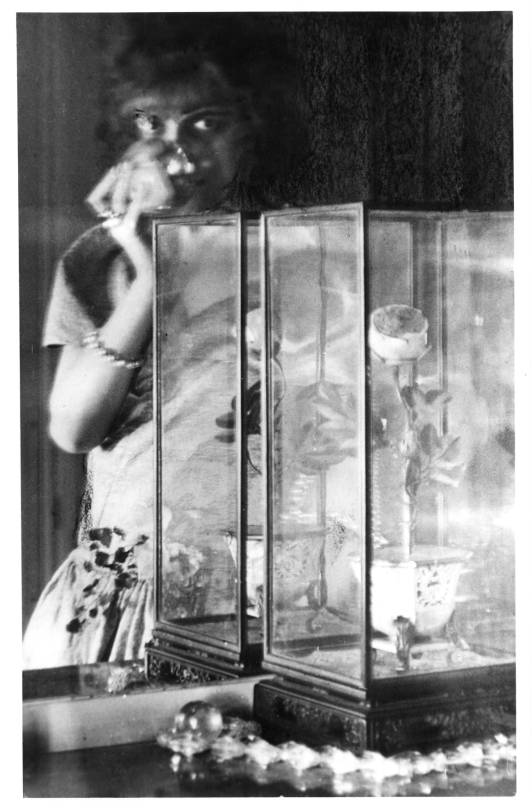
1922 Man Ray, Marchesa Luisa Casati.
"In 1922, Luisa visited a young and still unknown photographer named Man Ray. In his autobiography, the American tells the story of the photo that became the most famous of all the representations of the Marchioness Casati (...) "I drew a few where one could distinguish a semblance of face; On one of the negatives, we saw three pairs of eyes. It could have been mistaken for a surreal version of the Medusa. It was precisely this photo that delighted her: I had made a portrait of her soul, she said, and she ordered dozens of copies from me. I wish my other clients had been so easy to please. The photo of the marquise went around Paris. Figures from the most closed circles began to come, all expecting miracles. I had to leave my hotel room and find a real studio. » (x)
#1922#portrait#man ray#marchesa luisa casati#luisa casati#marchesa casati#marquise casati#Marquise luisa casati#la Marquise#luisa amman casati#Luisa Adele Rosa Maria von Amman#Luisa Adele Rosa Maria Amman#Luisa Amman#Marquise Casati Stampa di Soncino#Marchesa Casati Stampa di Soncino#Luisa Marchesa Casati Stampa Di Soncino#Luisa Casati Stampa di Soncino#Marchesa Casati Stampa
151 notes
·
View notes
Text




Lady Gaga's look is inspired by these photos taken by Cecil Beaton of Marisa Berenson dressed as Marchesa Louisa Casati for Vogue US' "Remembrance of Things Proust" in January 1972.
#lady gaga#stefani germanotta#haute couture#fashion#fashion editorial#marchesa casati#vogue us#vogue magazine#marchesa louisa casati#marcel proust#remembrance of things proust#january 1972#cecil beaton#marchesa luisa casati stampa#black and white photography#sepia photography#december 2021#british vogue#vogue italia
169 notes
·
View notes
Text
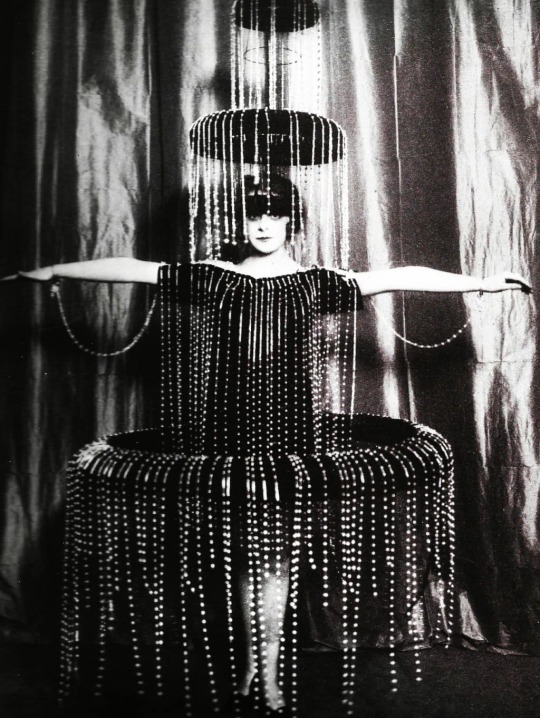

THE MARCHESA CASATI
Marchesa Luisa Casati: An inspiringly decadent true tale of a bizarre Italian aristocrat. Pet cheetahs, séances and dresses made from lightbulbs, the heiress, socialite and artist's muse Marchesa Luisa Casati led a life every bit as unusual as her outfits.
Luisa, Marchesa Casati Stampa di Soncino (born Luisa Adele Rosa Maria Amman; 23 January 1881 – 1 June 1957), was an Italian heiress, muse, and patroness of the arts in early 20th-century Europe.
Casati was known for her eccentricities that delighted European society for nearly three decades. The beautiful and extravagant hostess to the Ballets Russes was something of a legend among her contemporaries. She astonished society by parading with a pair of leashed cheetahs and wearing live snakes as jewellery.
She captivated artists and literary figures such as Robert de Montesquiou, Romain de Tirtoff (Erté), Jean Cocteau, and Cecil Beaton.[citation needed] She had a long-term affair with the author Gabriele d'Annunzio, who is said to have based on her the character of Isabella Inghirami in Forse che si forse che no (Maybe yes, maybe no) (1910).[citation needed] The character of La Casinelle, who appeared in two novels by Michel Georges-Michel, Dans la fete de Venise (1922) and Nouvelle Riviera (1924), was also inspired by her.
In 1910, Casati took up residence at the Palazzo Venier dei Leoni, on Grand Canal in Venice, owning it until circa 1924. In 1949, Peggy Guggenheim purchased the Palazzo from the heirs of Viscountess Castlerosse and made it her home for the following thirty years. Today it is the Peggy Guggenheim Collection, a modern art museum on the Grand Canal in the Dorsoduro sestiere of Venice, Italy.
Casati's soirées there would become legendary. Casati collected a menagerie of exotic animals, and patronized fashion designers such as Fortuny and Poiret. From 1919 to 1920 she lived at Villa San Michele in Capri, the tenant of the unwilling Axel Munthe. Her time on the Italian island, tolerant home to a wide collection of artists, gay men, and lesbians in exile, was described by British author Compton Mackenzie in his diaries.
Numerous portraits were painted and sculpted by artists as various as Giovanni Boldini, Paolo Troubetzkoy, Adolph de Meyer, Romaine Brooks (with whom she had an affair), Kees van Dongen, and Man Ray; many of them she paid for, as a wish to "commission her own immortality".[citation needed][citation needed] She was muse to Italian Futurists such as F. T. Marinetti (who regarded her as a Futurist) Fortunato Depero, Giacomo Balla (who created the portrait-sculpture Marchesa Casati with Moving Eyes), and Umberto Boccioni. Augustus John's portrait of her is one of the most popular paintings at the Art Gallery of Ontario; Jack Kerouac wrote poems about it and Robert Fulford was impressed by it as a schoolboy.
11 notes
·
View notes
Text
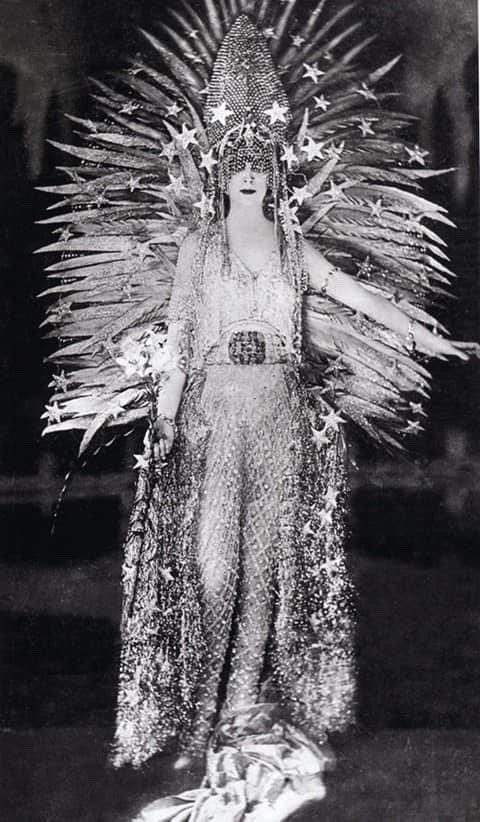
THE MARCHESA CASATI
Luisa, Marchesa Casati Stampa di Soncino (born Luisa Adele Rosa Maria Amman; 23 January 1881 – 1 June 1957), was an Italian heiress, muse, and patroness of the arts in early 20th-century Europe.
Casati was known for her eccentricities that delighted European society for nearly three decades. The beautiful and extravagant hostess to the Ballets Russes was something of a legend among her contemporaries. She astonished society by parading with a pair of leashed cheetahs and wearing live snakes as jewellery.
79 notes
·
View notes
Text
Before there was Gaga there was Marchesa Casati.
Prepare to be astonished.






Luisa, Marchesa Casati Stampa di Soncino, was an Italian heiress, muse, and patroness of the arts in early 20th-century Europe.
5 notes
·
View notes
Photo

🔸 Described by Pablo Picasso as “dressed in a pearl-embroidered gown with a stiff elizabethan ruff and a neckline that plunged to her navel”, Marchesa Luisa Castai was an Italian heiress that is too incredible to be forgotten. Born in 1881 in Milan, Luis Casati was brought up in a highly affluent yet dysfunctional family. Her father was made a count a King Umberto I and when both her parents passed away by the time Casati was 15, making Casati and her older sister Francesca, reportedly the wealthiest women in Italy. At 19 she was married to Count Camillo Casati Stampa di Soncino, however her subsequent affair with poet Gabriella d’Annunzio caused Casati transformation into an ecentric femme fatale, the epitome of belle epoque. Photo taken c.1905 Source: ladycultblog #victorianchaps #oldphoto #retro #luisacasati #eccentric #oldphoto #goodolddays #fashion #beauty #icon #vintage #edwardian #1900s #nostalgia #pastlives https://www.instagram.com/p/CeJpkV-g4l7/?igshid=NGJjMDIxMWI=
#victorianchaps#oldphoto#retro#luisacasati#eccentric#goodolddays#fashion#beauty#icon#vintage#edwardian#1900s#nostalgia#pastlives
9 notes
·
View notes
Text

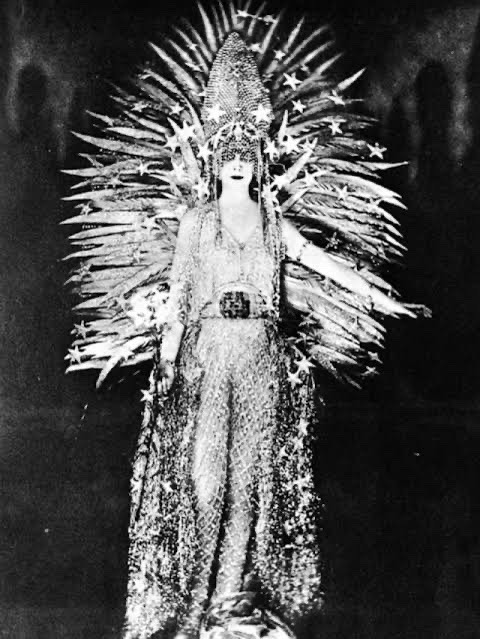
Luisa, Marchesa Casati Stampa di Soncino was an Italian heiress, muse, and patroness of the arts in early 20th-century Europe.
Born into a cocoon of privilege in 1881, Luisa was the second daughter of a rich Austian cotton merchant living in Milan, who would later be given the title of count by King Umberto I. A plain and introverted child, she quietly absorbed the delights of Milan’s museums, galleries, and libraries, which instilled in her an appreciation of the avant-garde art that was gradually becoming popular at the turn of the century. It was in these early years that Luisa became fascinated by history’s notorious eccentrics, including the ’Swan King’ Ludwig of Bavaria, who’s outlandish behaviour, construction of extravagant castles, and patronage of the arts would be a significant influence on the Marchesa's later years.
With an abundance of wealth behind her, the Marchesa began to tailor her lifestyle into a plethora of flamboyant dress and unconventional behaviour. Her reputation spread throughout Europe, with stories of lavish and fantastical soirees, of servants painted in gold leaf, and of the Marchesa’s penchant for wearing live snakes as jewellery. She began to collect elaborate mansions, such as the red marble Palais Rose near Paris, which included a summer house gallery housing the hundreds of portraits she had sat for. Elsewhere she kept a large menagerie of animals, including monkeys, snakes, and two cheetahs with whom she would stroll through the streets at night. In Venice, she would often take her ocelots and borzois on walks outside her palazzo wearing nothing but a fur coat, pearls, and a face full of makeup. Guests reported collections of eerie mannequins that sat around her dining table as if to accompany the guests, and the Marchesa added fuel to these rumours by hinting they contained ashes of her past lovers.

Luisa's raison d’etre became ‘immortality through art’ and she began to seek out progressive artists, commissioning them to take her portrait by paint or lens and sometimes funding their living costs. This exchange differed somewhat from traditional, contemptuous relationship between the artist and the bourgeoisie; she maintained friendships with many she worked with and patronised the most innovative of artists. Her lifestyle was so intricately sewn with aesthetic excess and unconventionality that it appealed greatly to bohemian artistic sensibilities. Poiret dressed her; Augustus John painted her; the Italian futurists idolized her. In John Richardson’s biography of Picasso, he produces an anecdote about one of Casati’s infamous dinner parties.
Although no artist by traditional means, the Marchesa’s appearance was her canvas and she cultivated an enchanting personal style which captivated the aesthetes and bon vivants she consorted with. With her long, lean, pearl white body draped in outlandish finery, chaotic mess of fiery red hair, slash of scarlet lipstick, and striking kohl rimmed eyes, the Marchesa had the glamorous allure of a vampire, hungrily sucking up beauty, excess, and other visual delights.
She dressed in the high fashions of the day, but had many outlandish outfits specially tailored from her own ideas. One such example, which was worn to a ball in 1922, was decorated with dozens of tiny light bulbs, powered by a generator beneath her skirt, and reportedly gave the Marchesa tiny electric shocks throughout the night.
In portraits, she is most often shown with a tangle of hair dyed bright orange, intense eyes, and chiseled cheekbones. There is nothing muted about her approach to appearance. Casati stretched beauty’s limits even by today’s standards. She was six feet tall and accentuated her height with extravagant headpieces. Accounts say she took doses of belladonna, a poisonous plant, to dilate her pupils and make them darker. She didn’t stop there: She topped her unnaturally obscure eyes with rows and rows of fake eyelashes—sometimes fashioning them out of strips of fabric—and powdered her skin porcelain. She painted her face in stark black and white, like a photograph of the period.
2 notes
·
View notes
Text
Casa-Museo Mariano Fortuny y Madrazo a Venezia, riapertura di un luogo incantevole
https://www.librarte.eu/post/casa-museo-mariano-fortuny-y-madrazo-a-venezia-riapertura-di-un-luogo-incantevole
cura di Manuela Moschin
L'articolo è stato scritto per il sito La voce di Venezia Clicca qui per il link La Voce di Venezia Mi potete seguire anche nel gruppo Facebook Storie di Libri di Pasquale Cavalera. Clicca qui: Link Storie di Libri e nella pagina Facebook https://www.facebook.com/librarte.blog
L’eccezionale acqua alta che colpì Venezia il 12 novembre 2019 danneggiò in modo significativo anche il piano terra del Palazzo Pesaro degli Orfei, luogo in cui si trova la Casa-Museo Mariano Fortuny y Madrazo. Mercoledì 9 marzo 2022 è stata riaperta con grande soddisfazione.
Fu il figlio d’arte Mariano Fortuny nato nel 1871 a Granada, che a diciotto anni si stabilì a Venezia, risiedendo poi nel Palazzo, dove curava il suo atelier. Il Museo è un luogo a dir poco incantevole, che testimonia l’ingegno e la capacità artistica di una figura eclettica, che diede particolare valore alla cultura. Fu amico di Gabriele D’Annunzio, Eleonora Duse, Ugo Ojetti, la marchesa Casati, Hugo von Hofmannsthal, Giovanni Boldini e il principe Fritz Hohenlohe-Waldenburg. Grande ammiratore di Richard Wagner, si ispirò alla sua musica per creare opere d’arte, interessandosi di scenografia e illuminotecnica, compiendo dunque una fusione tra la musica e la pittura teatrale. Realizzò finanche alcune scene e costumi per la prima del Tristano e Isotta alla Scala di Milano. Nel 1919 fondò alla Giudecca la nota fabbrica di stoffe, aprendo boutique in varie città europee.
Il Palazzo gotico veneziano venne fatto costruire dal nobile Benedetto Pesaro (1433-1503) a partire dalla metà del Quattrocento ed è situato sul campo San Beneto. Quando Mariano Fortuny nel 1898 entrò nel Palazzo per la prima volta, trovò la struttura in stato di degrado. Con il passare degli anni fece in modo di recuperare l’edificio, che divenne un luogo di sperimentazioni artistiche e scenotecniche, diventando la sua dimora, nonché un laboratorio per la stampa su tessuto. Assieme alla moglie Henriette Nigrin installò l’atelier, creando abiti e tessuti in seta stampati. Fortuny fu un personaggio poliedrico che diede origine a dipinti, incisioni, sculture, fotografie, disegni, lampade tecniche e per l’arredo, modelli teatrali, tessuti stampati, abiti e costumi per la scena. La collezione del Palazzo Fortuny è costituita da una grande quantità di oggetti che interessano quindi diversi ambiti, come la pittura, la fotografia, il tessile.
Per quanto riguarda la pittura è doveroso dare particolare risalto al Giardino d’inverno un salotto impreziosito da decorazioni parietali, animato da figure femminili, immagini allegoriche con satiri e animali esotici. Il tutto inserito in un ambiente architettonico affascinante, situato in una loggia corinzia di grande effetto, ornato da motivi floreali, vegetali, ghirlande e da grottesche. L’immagine del presente articolo raffigura solo una parte di questo spettacolo scenografico per la cui esecuzione Mariano inventò una speciale intelaiatura di carta incollata su teli di canapa, dipinti e fissati alle pareti. Nella medesima stanza è conservato il modello del Teatro delle Feste, progettato da Mariano con la collaborazione di Gabriele D’Annunzio e dell’architetto francese Lucien Hesse. Inoltre, la collezione comprende circa 150 dipinti di Mariano Fortuny, alcuni legati alla ritrattistica raffigurante la sua famiglia, oltre a nudi femminili, nature morte e la pittura rivolta al ciclo wagneriano, del quale spicca il dipinto avente come tema Parsifal, intitolato Le Fanciulle - fiore del 1896. Peculiare rilevanza, invece, per quanto riguarda i tessuti, è la Collezione tessile, soprattutto il Delphos, per la cui realizzazione Mariano si ispirò osservando il chitone ionico, la veste della scultura greca dell’Auriga Delfi rinvenuta nel 1896.
Mariano Fortuny morì il 2 maggio 1949 e dopo la sua morte l’edificio fu donato dalla moglie Henriette al Comune di Venezia, che lo possedette nel 1965. Nel 1975 il Museo venne aperto al pubblico.





1 note
·
View note
Photo

La Marchesa Casati , ca 1913
Adolf de Meyer :: La Marchesa Luisa Casati (aka La Casati) photographed with her head resting on her arms, with pearls draped over her arms, taken circa 1913. | src Getty Images
view on wordPress
#adolf de meyer#adolph de meyer#baron adolf de meyer#la casati#la divina marchesa#luisa casati#1910s#marchesa luisa casati#1913#baron adolph de meyer#stampa#portrait#socialite#celebrity#notorious#Bildnis
72 notes
·
View notes
Photo

Marchesa Luisa Casati
Portrait by Federico Beltrán Masses, 1920.
#Marchesa Luisa Casati#Federico Beltrán Masses#1920#Luisa Casati#Federico Armando Beltrán Masses#Beltrán Masses#Luisa Marchesa Casati Stampa di Soncino#la casati#marchesa casati#la marchesa casati#marquise luisa casati#marchesa#muse#fashionista
259 notes
·
View notes
Photo





achilleidol: La Divina Marchesa Luisa Casati Stampa. Musa ispiratrice dei più grandi artisti della sua epoca. Grande mecenate, performer prima della performing art e opera d’arte vivente.
567 notes
·
View notes
Photo
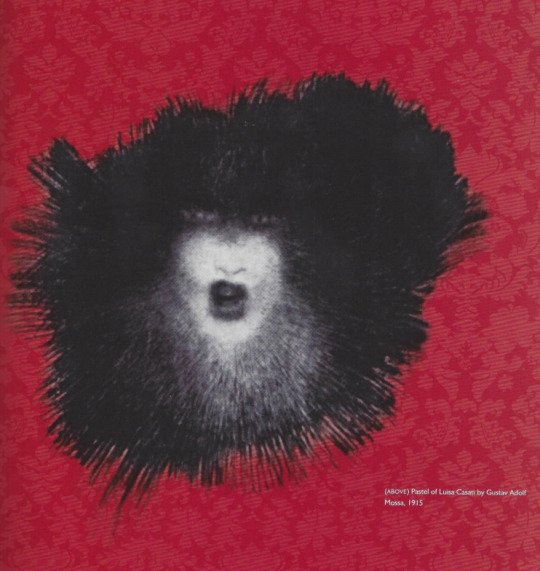
Gustav Adolf Mossa, Pastel of Marchesa Luisa Casati. 1915
Luisa was on holiday in Nice when she chanced accorss the work of Gustav Adolf Mossa. This French symbolist dedicated his craft to rendering fantastical creatures of myth – many of them in ghoulish feminine forms with bloodied lips and nightmarish eyes. His unsettling pastel vision of Luisa reduces her to a shrieking, nonhuman elemental force. At least in part, Mossa perhaps meant the almost perceptible scream from his siren-like subject to echo the horror and indignation expressed by so many at the recent start of the First World War. (x)
#gustav adolf mossa#pastel#painting#1915#art#marchesa luisa casati#la casati#mossa#la marchesa#luisa casati#marquise casati#marchesa#marquise#marchesa casati#Marchesa Luisa Casati.#Marchesa Casati Stampa#casati#stampa#Marquise Casati Stampa di Soncino#Marchesa Casati Stampa di Soncino#Luisa Marchesa Casati Stampa Di Soncino#Luisa Casati Stampa di Soncino#luisa amman casati#Luisa Adele Rosa Maria von Amman#Luisa Adele Rosa Maria Amman#amman#Luisa Amman#Marquise luisa casati#la Marquise
124 notes
·
View notes
Text

Marchesa Luisa Casati (1881 - 1957) wearing an extravagant Paul Poiret gown with a greyhound by Giovanni Boldini, 1908.
Luisa, Marchesa Casati Stampa di Soncino (born Luisa Adele Rosa Maria Amman; 23 January 1881 – 1 June 1957), was an Italian heiress, muse, and patroness of the arts in early 20th-century Europe.
Giovanni Boldini (31 December 1842 – 11 January 1931) was an Italian genre and portrait painter who lived and worked in Paris for most of his career. According to a 1933 article in Time magazine, he was known as the "Master of Swish" because of his flowing style of painting.
Early Life:
Boldini was born in Ferrara, Italy on 31 December 1842. He was the son of a painter of religious subjects, and the younger brother of architect Luigi (Louis) Boldini. In 1862, he went to Florence for six years to study and pursue painting. He only infrequently attended classes at the Academy of Fine Arts, but in Florence, met other realist painters known as the Macchiaioli, who were Italian precursors to Impressionism. Their influence is seen in Boldini's landscapes which show his spontaneous response to nature, although it is for his portraits that he became best known.
Career:
Moving to London, Boldini attained success as a portraitist. He completed portraits of premier members of society including Lady Holland and the Duchess of Westminster. From 1872 he lived in Paris, where he became a friend of Edgar Degas. He became the most fashionable portrait painter in Paris in the late 19th century, with a dashing style of painting which shows some Macchiaioli influence and a brio reminiscent of the work of younger artists, such as John Singer Sargent and Paul Helleu.
He was nominated commissioner of the Italian section of the Paris Exposition in 1889, and received the Légion d'honneur for this appointment. In 1897 he had a solo exhibition in New York. He participated in the Venice Biennale in 1895, 1903, 1905, and 1912.
Boldini died in Paris on 11 January 1931.
In a write up in The New York Times in January 1931, his career was summed up as follows:
Boldini was a fashionable portrait painter. He 'did' all the grandes dames of Paris, and at a certain period to have a portrait painted by Boldini was a crowning event of social season. His style was racy and advanced for his time, and he believed that his décolleté paintings touched the extreme limit of convention. His work was the talk of numerous salons. And then he was superseded by Vandongens and Etcheverrys and Domergues and others whose daring shocked and discouraged Boldini. He had not painted for many years before his death. His body was taken to Ferrara, his native city, for burial.
After his death, his work continued to be exhibited around the world. An exhibition of his work was held in 1938, seven years after his death, at the Newhouse Galleries in New York City.
In popular culture:
Boldini is a character in the ballet Franca Florio, regina di Palermo, written in 2007 by the Italian composer Lorenzo Ferrero, which depicts the story of Donna Franca, a famous Sicilian aristocrat whose exceptional beauty inspired him and many other artists, musicians, poets and emperors during the Belle Époque.
A Boldini portrait of his former muse Marthe de Florian, a French actress, was discovered in a Paris flat in late 2010, hidden away from view on the premises that were unvisited for over 50 years. The portrait has never been listed, exhibited or published and the flat belonged to de Florian's granddaughter, who inherited the flat after her father's death in 1966 and lived in the South of France after the outbreak of the Second World War and never returned to Paris. A love-note and a biographical reference to the work painted in 1888, when the actress was 24, cemented its authenticity. A full-length portrait of the lady in the same clothing and accessories, but less provocative, hangs in the New Orleans Museum of Art.
The discovery of his painting in the 70-years-empty apartment forms the background to Michelle Gable's 2014 novel A Paris Apartment.
Thanks to @lamarchesacasati for extra details!
#marchesa luisa casati#greyhound#dogs#dog#canines#canine#italian artists#italian artist#italian painter#italian painters#genre art#genre artist#portrait art#portraits#portraiture#portrait painter#portrait painters#luigi (louis) boldini#realist art#realism#macchiaioli#impressionism#impressionist art#realism movement#realist movement#landscape art#landscape artist#portraitist#19th century art#paul poiret
4 notes
·
View notes
Note
so what is sanremo? is it like eurovision?
Sanremo (technically the “Italian Song Festival") is the Italian music contest and it’s hosted every year in the town of Sanremo (duh) since 1951 - the winner goes to compete at Eurovision. It’s so popular that it reaches a 50% share regularly. It’s usually the festival of the boomers and of the ballads (hence the Eurovision entries from Italy every year……….), but last year it was a bit of a mess, of a one off: the public said that the voting was rigged (???) because Mahmood won instead of someone called Ultimo (who just didn’t deserve to win lmao), who was the public’s favourite (proof that the public doesn’t understand shit). Except this year it’s been a complete utter sequence of jaw-dropping moments: before the festival, the main host, Amadeus, congratulated his women co-hosts for being able to “stay one step behind their men” and dug a deeper hole when he tried to explain that the sentence hadn’t come out right, causing quite the uproar. During the Festival: Elettra (softly: Elettra) Lamborghini, granddaughter to that Lamborghini, twerked in the face of the public, and then almost kissed MYSS KETA; two male dancers danced to the Tango de Roxanne and were joined by Georgina Rodriguez (they said bi rights), Mika, Dua Lipa and Lewis Capaldi performed; Achille Lauro is systematically, metaphorically giving the finger to the conservatives and toxic masculinity: first he went on stage with a see-through glittery bodysuit, then during the “cover songs” night, in which people sang as duos, as ZIGGY STARDUST to sing a song written by a woman called Men never change, and throughout the song he stayed ONE STEP BEHIND Annalisa, who was singing with him, also keeping the og pronouns; a contending duo had a spat live, one of them, Bugo, disappeared off the stage, and we found out that the main host, Amadeus, looked for him THROUGHOUT THE CITY UNTIL 5AM LMAO; Ghali came to serve looks (as he does) and rapped in Arabic (Mahmood was attacked last year for not being ‘Italian enough’) so he was errrr, making several points; Roberto Benigni (who directed La Vita è Bella) came on stage and suggested everyone just had an orgy live, directed by the orchestra conductor, then talked about the Song of Solomon for about thirty minutes, explaining in excruciating detail how it’s about sex and shagging and recited A WHOLE FUCKING BIT OF IT including parts like, and I quote, “His testicles are roses dripping myrrh, his sex is a gold case filled with gems, all of him is desire, sweetness to suck,” one of the co-hosts, Fiorello, just decided to kiss as many men as he could and said that Amadeus “gave him herpes” so now we are shipping them??? fioreus??? amadello??? Yesterday the show ended at 3.30am, when Italians had already deteriorated on their sofa, and our God Achille came on stage dressed likeLuisa Marchesa Casati Stampa.
THIS YEAR WE SAID FUCK THE BOOMERS, IT’S ALL ABOUT THE SEX AND THE GAYS. WE STAY WINNING. TONIGHT IS THE FINAL NIGHT AND WE ARE READY TO WATCH IT UNTIL 4AM. WE ARE CAFFEINATED AND FERAL.

294 notes
·
View notes
Text
Probably almost all of you know how much I love Gucci, their Ideas and philosophy so, I guess you should’ve seen this post coming.
For the non italian followers (which should be 90% of my followers) this dude stage name is Achille Lauro. Born in the 90′s. He is considered a “Rapper” but to me he’s more of a POP/PUNK icon.
This year he got on Sanremo (the italian music song contest) with a Song named “Me ne Frego” (meaning “I don’t care”) and all his looks were created by Gucci’s artistic director Alessandro Michele based on the idea of Lauro of showing a life of just “not caring”, doing what people want to without a negative side to this idea.
He said that during this journey we’d meet 4 Characters, each of them represented by a Wolf, A Thunder, a Mask and a Crown. I didn’t guess even one right and that is extremely amazing because it means they weren’t predictable; everything was so well thought that it was impossible to understand it before he showed it to us.
I. Night - SAN FRANCESCO
San Francesco was the son of a very rich man who, in order to follow God’s call and help the poor, he got rid of his Noble Man Cape and remained naked, giving up to all his wealth and privileges.
Lauro gets on stage with a Gucci custom made black velvet cape, all embroidered in gold. He walks the stage barefoot and, at the climax of his song, he takes off the cape remaining with a body suit covered in crystals (of course he couldn’t get there naked xD)
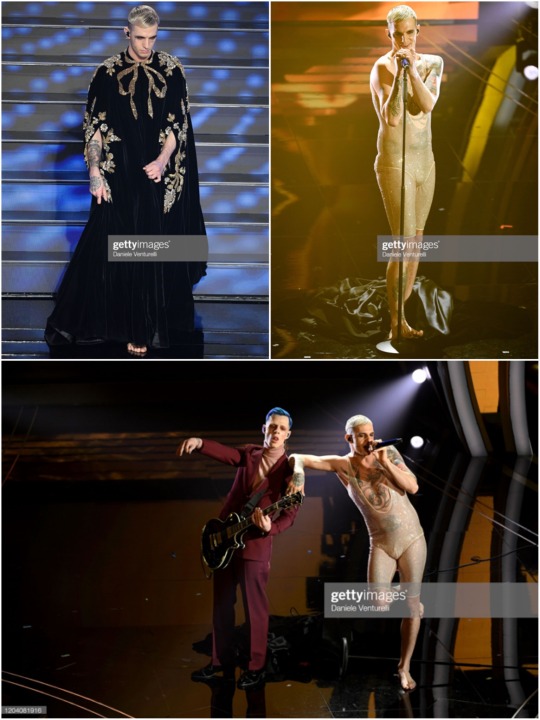
Beside the symbolic meaning of solidarity to the minors and the ones in need, I want to focus on the clothes ofc.
The cape was extremely beautiful, elegante, regal, the pearls and the studs made it look even more expensive. When he undressed, he showed us this bodysuit which was surprisingly fitting him very nicely. Nobody could see that happen.
As always, beside Lauro, there is his guitarist and friend Boss Doms. He was wearing a Burgundy suit with a blush pink turtle neck and red eye make up. He was looking stunning, totally uncoordinated with Lauro outfit YET perfectly matching.
II. Night - ZIGGY STARDUST
This character was created by David Bowie and it’s the representation of a rebellious soul, emblem of absolute artistic and sexual freedom and of non toxic masculinity.
As I said in my post about the Men Gucci FW Show, for this season Michele goal was, in fact, killing toxic masculinity and this idea perfectly matched Lauro performance.
During this night, He sang a cover of a song by Mia Martini, called “Gli uomini non cambiano” (”Men never change”); he sang it using all female nouns and, on his ig page, he posted an handwritten letter addressing it to “Disgusting Fifty years old homophobic men” saying that he knows those people too well due to his past and that he now wants to be rebellious and go against them, making peace with this femininity and when they ask him why he wears female things, he just replies “I’m becoming a Lady”.

The song was very touching, I suggest you listening to it, but back to the outfit: He has an emerald green satin suit, all custom made (on the left arm you can see a patch with his name embroidered on it), a striped shirt with a 80′s style collar and a glittery tie. His makeup and hairstyle is exactly the same as Ziggy Stardust and, once again, i want to compliment the makeup artist for the amazing Job.
Probably this was the most “complete” look.
Boss Doms is, once again, in a suit. Blue with red details. he’s wearing a tiara from the last Gucci Cruise collection and on his face there are tears made of stardust. One again, completely different, amazingly matching.
III. Night - MARCHESA LUISA CASATI STAMPA
She was a very popular woman who became the muse of a lot of artist during her era. She was the lover of the poet Gabriele D’annunzio. She was eccentric and without any boundaries.
They say that she used to walk at night at Piazza San Marco in Venice completely naked, with just a fur on her shoulders (sometimes walking a jaguar with her) and having a servant lighting her so that everybody could admire her.
She had many lovers, she was very “free” even in the sexual aspect of her life so, once again, we see the concept of freedom being strongly represented in Lauro performance.
She was known mostly for having sponsored many artists and collected every sort of art since her home was full of art and exotic things (even animals); people used to say that she was walking art herself thanks to the makeup and dresses she used to wear

Lauro gets on stage with a head piece made of feathers, diamonds and studs (that wasn’t custom made, it was used in last year fashion week); he wore Gucci stockings embroiled with black diamonds in the shape of the typical “GG” the logo; on top of it an organza cape.
The best pieces were the glove which held two Gucci Lipsticks (one of which he used to put on himself and his friend during the song) and the pointy leather boots that, once again, had his name printed inside.
The best part, to me, of this look was the makeup. It was a shiny black/red shadow, which contoured all his eyes, making him look somehow vampire-ish.
At his side, Boss Doms with an amazing velvet Jacket and elegant black slacks, a Pussy Bow pink shirt and the most beautiful smokey eyes I’ve ever seen in my life.
I might be wrong here but I think that, in this case, he should have represented the servant that walked Miss Casati around Venice, but maybe I am Wrong.
IV. Night - QUEEN ELISABETH I THE VIRGIN QUEEN
For the last night, he got inspired by the Virgin Queen, married to her country, who fought for arts, freedom and died without wanting any medication and being a queen up to her last day, never abdicating.
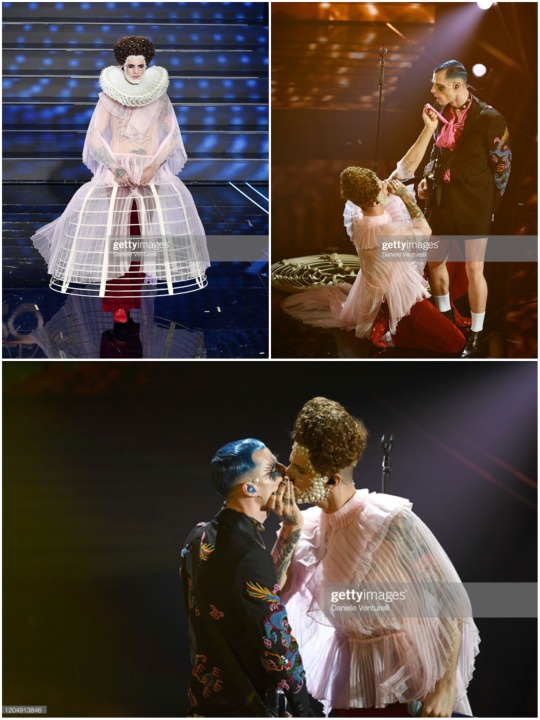
The velvet pants, along with the red boots and the pearls makeup, have been shown on Gucci runways already, but they were able to put all together in order to create the perfect representation of the character.
Boss Doms was wearing a beautiful embroidered jacket (I guess they were Chinese dragons but I can’t see it properly), He was wearing shorts, giving a very strong AC/DC vibe to his look.
He had a matching makeup with pearls on his temples and jaw and, around his eyes, he had holographic fake lashes.
Being the last night, they went even further on stage, completing it with a kiss (as they actually always do during every performance they have).
So, my final thoughts:
First thing first, I want to underline the fact that not even one of the nights the look they showed gave out a “costume” vibe; they were pure outfits, stage outfits which, every time, enchanted one of the aspect of the song.
Lauro never looked “ridiculous” or like “too femminine”, he looked powerful, serious, without any limit.
They represented freedom, freedom of being whoever you want, having the power to fight all those boomers who kept on attaching them, who kept on criticizing them.
During today interview, when somebody told him that he should have focused more on the song rather than the “look” he answered that he has a project, and the song was just a tool to deliver the message of his project. He didn’t want to win the festival, he just wanted to be remembered.
And he did.
I think he should be really thankful to all his creative staff, to Alessandro Michele who believed in him as an ambassador of this same message and I do really really hope to see more collaborations like this because he’s a very sensitive soul, he is a great gentleman, he never yells, he never replies in an angry way and he has a very kind smile.
And this world needs more kindness and more beauty.
204 notes
·
View notes
Photo

John Galliano for Dior | 1998⠀ ——⠀ Galliano sought inspiration in the eccentric Italian socialite and patron of the arts, Marchesa Casati Stampa di Soncino, for his Spring/Summer 1998 Couture collection for Dior. This opera coat looks as if it was plucked straight out of Poiret’s atelier with it’s kimono silhouette and decadent nouveau embroidery and beading. ——⠀ #Dior #ChristianDior #Galliano #JohnGalliano #fashion #design #costume #glamour #decadence #90sfashion #couture #style #mode #moda #marchesacasati #poiret #artnouveau #velvet #history #fashionshow https://www.instagram.com/p/B63oCGDgIB4/?igshid=1gayw9rf7tdx3
#dior#christiandior#galliano#johngalliano#fashion#design#costume#glamour#decadence#90sfashion#couture#style#mode#moda#marchesacasati#poiret#artnouveau#velvet#history#fashionshow
201 notes
·
View notes